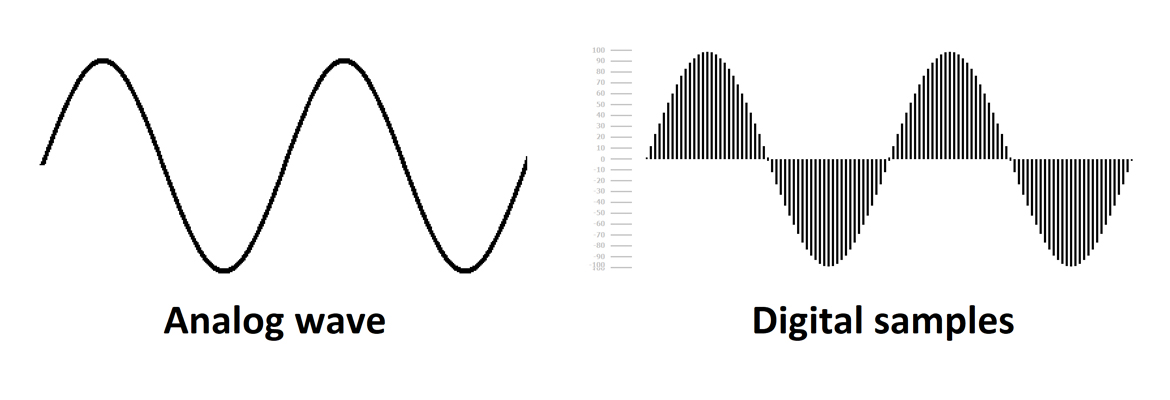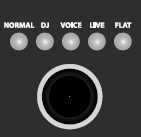What is a DSP?
DSP is an abbreviation for Digital Signal Processor.
For audio, this is a device which digitizes the audio signal, manipulates it in the digital domain and then converts it back to audio. Usually, the DSP is an Integrated Circuit (I.C. or chip) in a circuit with some additional components.

Digitizing, or converting the audio into digital information, involves taking measurements of the audio wave at very short, high frequency intervals to build a numerical image of the waveform. This is called Sampling. The sampling frequency is so high that it cannot be heard and is ultimately filtered out.

The stream of samples is then subjected to mathematical functions called Algorithms, which perform some processes that are similar to electronic audio processors but done entirely numerically. The digital stream is then converted back into an audio signal.
There are 2 main applications for DSPs in audio systems – Processing and Effects.
Processing
Processing is concerned with achieving the best quality audio signal and sound output possible.
A DSP may be employed in a Digital Speaker Management System, which is a device designed to manipulate the dynamics (loud/quiet profile) and frequency response in an audio signal so that it is most effective for the loudspeaker(s) being driver by an amplifier. This might entail removing any frequencies that the loudspeaker cannot physically reproduce, therefore eliminating wasted energy. It might also control the maximum loudness peaks in a signal to avoid damage to the loudspeaker.

Citronic Speaker Management System - 170.668UK
Some of the functions performed by a Digital Speaker Management System are described below:
Crossover - Filters that divide the bands of appropriate frequencies for amplifying to loudspeakers.
EQ - Filters that change the tonal character of the overall signal as required.
Limiter - A process to curtail loud peaks in the audio to avoid damage to equipment.
Compressor - A dynamics processor that can reduce loud sound peaks and increase quiet sounds.
Gate - Automatically mutes the output when the audio is quiet, so background noise isn’t heard.
Delay - Unlike the delay effect (below) this is used to “time-align” speakers that are far apart.
Phase - A switch that inverts the signal when a speaker is aligned to cancel another one out.
A more basic version of the Digital Speaker Management System can be found on some active speakers. This usually has stripped down features or a simple selection of pre-set tonal and dynamic profiles, usually controlling the low frequency drivers (woofers) and high frequency drivers (tweeters) separately.

Effects
Audio effects are used to create a deliberate change in the signal, adding special character or special qualities to the sound. There are many different types of audio effects but some of the most prevalent are detailed below.

Delay (digital delay) is an effect whereby the digitized audio signal is stored in the DSP memory for a measure of time and then played back with the original Dry signal before converting back to audio. The delayed signal is most often reduced in volume compared with the original audio signal. This mimics an Echo effect and the delayed signal can also be delayed again to Regenerate and develop several Repeats.
Different types of Delay effect are classified by their name:
Slapback is a short, abrupt delay with minimal repeats.
Short delay, as its name suggests is a very short time delay, used to thicken the original sound.
Double Tracking is a single repeat that is short enough to sound like the same sound in unison.
Long delay has a much longer delay time and usually has more repeats to build the sound in layers.
Multi-tap delay has several delayed signals repeating at independent times, similar to an old tape echo.
Panning delay has the delayed signal fading continuously between left & right in a stereo field.
Ping Pong delay delivers the repeats alternately between left and right in a stereo field.
Delay is often used to give vocal tracks an illusion of layers and pads out any emptiness in a mix.
Reverb (digital reverberation) is an emulation of natural ambience in a room or open space. This is achieved by creating a multitude of separate delayed signals (echoes) and layering and blending them together. The resulting effect gives an 'after-sound' of the original sound but without the discernible repeats that can be heard in a Delay effect. This fading 'after-sound' is called the Decay.
As with Delay, there are several types of Reverb, mostly describing the space they are trying to emulate:
Hall reverb, as the name suggests, emulates the ambience of a hall with a dull sound and long Decay.
Room reverb emulates a room, which is smaller than a hall and so has a shorter Decay.
Cavern reverb emulates a cavern and can be much more layered and longer than a Hall reverb.
Plate reverb simulates a studio effect which uses transducers on a metal plate to produce reverb.
Spring reverb simulates a guitar amp effect which uses transducers and metal springs to produce reverb.
Gated reverb is similar to a Room reverb with a gate to produce a hard cut-off of the reverb signal.
Reverse reverb builds inverted repeat layers up from nothing rather than decaying from loud to quiet.
Vocal reverb is a generic reverb type designed to be most useful for singers.
Ambient reverb is usually a dulled (reduced high frequencies) reverb type to provide some pad to a mix.
Early Reflections are short delays that form the first part (or Attack) of a reverb, here used on their own.
Delay and Reverb are known as Time-Based or Spatial effects, since they use time delayed repeats. Another branch of audio effects is known as Modulation, where one or more of the effect parameters is being constantly varied by an LFO (low frequency oscillator), producing an undulating or rotating quality to the effect.
Phasing is a process where the audio is split in 2 and one half is dragged behind in time slightly, so that it goes “out-of-phase” with the original Dry signal and then returns to being back in phase. The time delays used are very small and they affect bands of frequencies differently, causing a continuously moving Comb Filter effect.
Flanging is an old studio technique where 2 of the same tape recording were set to synchronised playback together. The studio engineer would press a hand against the flange of one tape reel, causing it to drag back in time, then release it so that it returned to sync with the original. It is similar to phasing but uses a longer delay time and often processors use regeneration to produce a stronger effect.
Chorus is also sometimes known as ADT (auto-double-tracking) and uses slightly longer delay times so that the filtering effects of phasing or flanging are not present, yet the delay is still short enough not to be heard as a separate sound. This delay is varied in time (as with phasing or flanging) to give the impression of natural variances when more than one of the same sounds are playing in unison. The resultant effect is to thicken the sound with a jangly, chiming quality.
Rotary is an effect originally created by a rotating speaker and is sometimes known as a “Leslie” effect from the original brand of this type of speaker. It is similar to phasing and chorus effects and was originally emulated by a pedal called a “Roto-vibe”. Often it is now a pre-set in a DSP effect section.
Vibrato is a constant variation of pitch, usually very subtle so that there is not too much deviation from the original pitch but enough to give a warbling effect.
Tremolo is a constant variation of volume, which can go from very subtle to hard and choppy. In a stereo system, this can be affected between left and right speakers to produce an Auto-Pan effect.
Wah is a filter effect that sounds like its name, shaping the vowel of the sound from “ooh” to “aah” and all points in between. This is traditionally achieved using a band pass filter in a rocker pedal but may be controlled by an LFO to produce and Auto-Wah effect. Similar effects have been developed to sound more like speech vowels. These are sometimes called Talk Box or Vocoder effects.
Pitch (pitch shifter or harmonizer) effects add one or more versions of the original signal that has been shifted up or down in pitch to provide a harmony. This may be purely in musical octaves up or down, which is known as an Octaver, or maybe any fixed pitch shift from the original (i.e. second, fourth, fifth or any interval) or even switching major and minor intervals intelligently based on a musical key signature, as in an Intelligent Harmonizer. Some pitch shifters have a Detune setting but often have no “rotating” modulation characteristics like Chorus, Phasing or Flanging.
There is almost no limit to what is audibly possible using DSPs, dependent only on the chip’s processing power and its clock speed. Therefore, the list of effects is still not yet complete but many of those found in a standard DSP effects engine are explained above. As always, experimentation is the only real way to know which is most useful or appropriate for any given program material.

